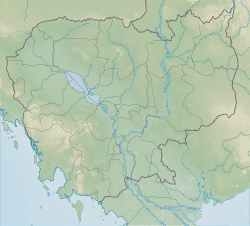Phnom Sorsia
| Phnom Sorsia | |
|---|---|
 White Elephant Cave, Phnom Sorsia | |
| Highest point | |
| Coordinates | 10°33′57″N 104°17′02″E / 10.56583°N 104.28389°E |
| Geography | |
| Location | Kampot Province, Cambodia |
Phnom Sorsia is a Buddhist hill complex in Kampot Province, southern Cambodia. It contains Buddhist cultural features approached by a staircase and a complex of karst caves. One cave Rung Damrey Saa ("White Elephant's Cave") has a stalagmite resembling the head of an elephant; another has a bat colony.[1] The gateway to the caves is marked by a pagoda, approximately 1 kilometre (0.62 mi) from the main road.[2]
Geography
The complex is located about 11 miles (18 km) east of Kampot. It is accessed via a dirt road which veers from the NH33; signage refers to the site as the Phnom Sorsia Resort.[3] Phnom Sorsia, Phnom Chhnork, Kep, and Bokor National Park make up a popular day trip of the Kampot Province.[4]
The forest-covered hill has several limestone caves. The White Elephant Cave is so named as there are many stalagmites in the limestone formations which resemble white elephants.[3] East of Phnom Sorsia is the "Bat Cave", with a population of several thousand bats.[1] They come out to the surface through a narrow chimney-type passage, and are hunted by bamboo-wielding local residents who swat at them while they are airborne.[3] A concealed pool with cool water is approached through a hole. The vistas from the top of the mountain are of rice fields.
Culture
Phnom Sorsia is considered a holy hill. Steps have been carved in the slopes in a winding formation,[5] to reach both the top of the mountain and the White Elephant Cave. Cultural features include two Buddha statues to the right of the White Elephant Cave, a garishly painted temple, as well as a stupa on top of the hill.[3]
-
White Elephant Cave
-
Phnom Sorsia, Kampot
-
Phnom Sorsia, Kampot
References
- ^ a b DK Travel Guides (1 June 2011). DK Eyewitness Travel Guide: Cambodia & Laos. Dorling Kindersley Limited. p. 115. ISBN 978-1-4053-4985-7.
- ^ Vater, Tom (29 December 2009). Moon Cambodia. Avalon Travel. pp. 164–. ISBN 978-1-59880-214-6. Retrieved 1 January 2013.
- ^ a b c d Nick Ray; Greg Bloom; Daniel Robinson (1 July 2010). Cambodia 7. Lonely Planet. pp. 229–. ISBN 978-1-74179-457-1. Retrieved 1 January 2013.
- ^ Williams, China (3 March 2010). Southeast Asia 15. Lonely Planet. pp. 121–. ISBN 978-1-74179-233-1. Retrieved 4 January 2013.
- ^ Vietnam, Cambodia, Laos & the Greater Mekong. Lonely Planet. 2007. p. 244. Retrieved 2 January 2013.
External links
 Media related to Phnom Sorsia at Wikimedia Commons
Media related to Phnom Sorsia at Wikimedia Commons






